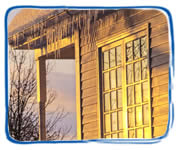Prepare Your Home for Winter Weather
Highlights
- Listen to weather forecasts.
- Check your emergency supplies.
- Have your chimney or flue inspected each year.
- Install a smoke detector and a battery-operated carbon monoxide detector. Test the batteries each month, and replace them twice a year.
- Weatherproof your home.
- Bring your pets indoors during the winter.
Prepare for extremely cold weather every winter—it’s always a possibility. There are steps you can take in advance for greater wintertime safety in your home.
Prepare Your Home for Winter
Although periods of extreme cold cannot always be predicted far in advance, weather forecasts can sometimes provide you with several days’ notice. Listen to weather forecasts regularly, and check your emergency supplies whenever a period of extreme cold is predicted.
If you plan to use a fireplace or wood stove for emergency heating, have your chimney or flue inspected each year. Ask your local fire department to recommend an inspector, or find one in the yellow pages of your telephone directory under "chimney cleaning."
 Also, if you’ll be using a fireplace, wood stove, or kerosene heater, install a smoke detector and a battery-operated carbon monoxide detector near the area to be heated. Test them monthly, and replace batteries twice a year.
Also, if you’ll be using a fireplace, wood stove, or kerosene heater, install a smoke detector and a battery-operated carbon monoxide detector near the area to be heated. Test them monthly, and replace batteries twice a year.
Your ability to feel a change in temperature decreases with age, and older people are more susceptible to health problems caused by cold. If you are over 65 years old, place an easy-to-read thermometer in an indoor location where you will see it frequently, and check the temperature of your home often during the winter months.
Insulate any water lines that run along exterior walls so your water supply will be less likely to freeze. To the extent possible, weatherproof your home by adding weather-stripping, insulation, insulated doors and storm windows, or thermal-pane windows.
If you have pets, bring them indoors. If you cannot bring them inside, provide adequate shelter to keep them warm and make sure that they have access to unfrozen water.
Checklist
- Insulate walls and attic.
- Caulk and weather-strip doors and windows.
- Install storm windows or cover windows with plastic from the inside.
- Insulate any water lines that run along outer walls (water will be less likely to freeze).
- Service snow-removal equipment.
- Have chimney and flue inspected.
- Install easy-to-read outdoor thermometer.
Contact Us:
- Centers for Disease Control and Prevention
1600 Clifton Rd
Atlanta, GA 30333 - 800-CDC-INFO
(800-232-4636)
TTY: (888) 232-6348 - Contact CDC-INFO







